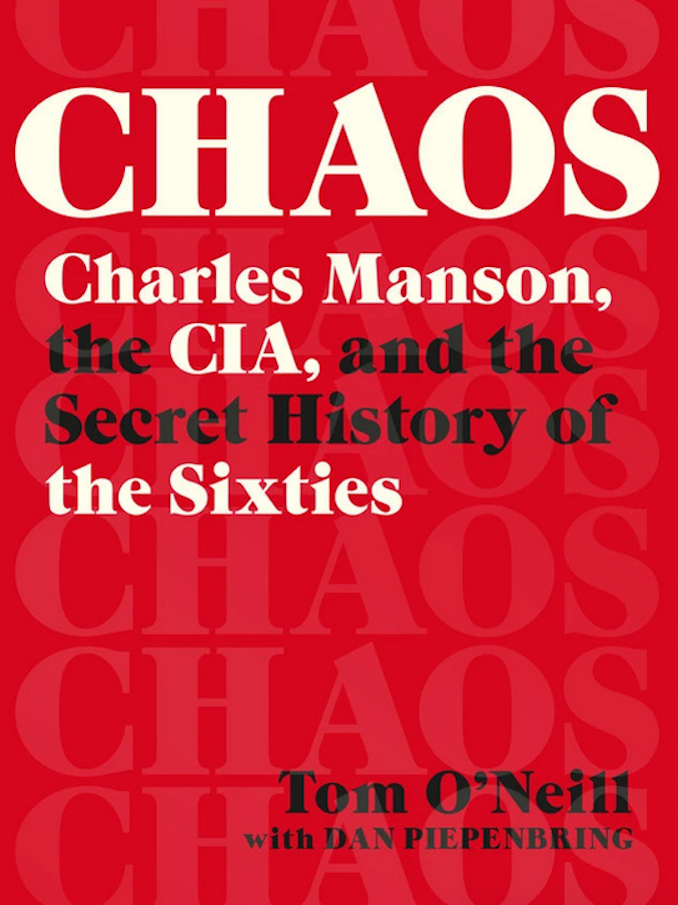
By John Dzwonczyk
The meta-story of Tom O'Neill's book, CHAOS, is the one that describes the ongoing sense of "I" for "Incomplete"—the grade the author himself would award his 20-year effort in producing it. It begins with the overt disconnection of information from narrative, the one which we today labor under to the point of rejecting basically everything that claims some gnostic transcendence—the sense that everything we encounter has a basis that is nebulous instead of solid. Interestingly, the dispute that O'Neill brings to the fore is not in any fashion that Charles Manson wasn't an evil mastermind of the exaggeratedly gruesome murders of his victims, but that his motives weren't the ones made famous by Vincent Bugliosi, whose principal fame arose from his bestselling chronicle of the murders, Helter-Skelter. The now-deceased Bugliosi and the author eventually became estranged over certain nuances that O'Neill claimed were whitewashed, less for prosecutorial convenience and more for a deeper, nefarious agenda that itself has seeped through everything we all today encounter.
MK-ULTRA, the often misapprehended CIA counterintelligence operation that began in 1953 and (though it probably still goes on in some advanced form today) was cancelled by agency director Richard Helms in the 1960s—with "all of its files being destroyed"—is proposed by O'Neill as Manson's actual master. However, apart from his probable but thinly documented association with it through the infamous Louis Jolyon West (who is a recurring character throughout the genre), one comes out of CHAOS with nothing substantially adding to the record. Still, O'Neill introduces enough shadowy figures who were around the late '60s LA "scene"—importantly, "Reeve Whitson" and Charles Tacot (woven unmistakably into an ecosystem that included intimate familiarity among Manson and his "family"), the Beach Boys, record producer Terry Melcher, the LAPD and Los Angeles County Sheriff's Office, Mama Cass and Papa John Phillips, and many others—that one cannot but weave this together with (RIP) Dave McGowan's Weird Scenes Inside the Canyon, which makes the case that the very music scene that we of a certain age were completely (and delightedly) immersed in was itself an intelligence operation intended to anesthetize Boomer resistance to aggressive U.S. foreign policies, which disastrously burned down like a Buddhist monk on a Vietnam street. It bears noting, though neither of these authors mentions it, that Frank Zappa (himself fingered by McGowan as being the scion of a military intelligence figure) has a line in his song "Plastic People,"—"There's this guy from the CIA and he's creeping around Laurel Canyon"—and Thomas Pynchon has a whole 1980s novel, Vineland, that centers around intelligence agencies infiltrating the California hippie scene of those "summer of love" days, for business and pleasure. So, the ideas here aren't new, per se.
I heard O'Neill on Joe Rogan and instantly recognized the Philadelphia patois that we sons of it acquire (and which is defiantly resistant to accurate synthesis), with the side benefit of easy evaluation of his sincerity. By that time, CHAOS was flying off the shelves and I had to wait until a week ago to get my copy, devouring its 442 pages quickly, in testimony to the author's craft (and I recall devouring Bugliosi's book when it was new). There is nothing like the hasty-pudding that is published by so many in the alternative research field that slows down reading like incessant typographical and other editorial errors, so some will be grateful (as am I) to see that that is no impediment here. Where I will criticize O'Neill is that I still think, despite his boldness in some cases to obtain information, he has found the MK-ULTRA cabinet bare, leaving me with the sense that he was heedful of the repeated warnings he got to "stay away!" in an Amityville Horror kind of way. I feel certain that whenever "files are burned," they are simply stowed out of sight, with the traces to them having been obliterated. Still, attack dogs and a secret police stand ready to rub out those who dare sniff a trail.
Which brings us to the current pathology of 2020, a time when our own clarity hardly approaches the clear view that is suggested by eye chart results of a similar value. Manson's Bugliosi-celebrated purpose was to bring about race war (which he seems to have associated with "Helter-Skelter," a crappy track on the bloated Beatles White Album). This is a theme that seems to have been resurrected from the ashes of burned crosses of the postbellum South and again, more recently, in the attacks on cities, landmarks, and statues. It's all a lot of reading, but who cannot see that these seemingly inscrutable actions to sow fear and division in America merely are updated versions from a well-worn playbook? Whether or not it's the CIA (who, as O'Neill hastens to reiterate, has no mandate on domestic soil), the FBI, an external foe, someone completely different, or a combination, can we not see that we are being—and have been—played throughout our lifetimes?
My own assessment is that our governmental apparatus has been thoroughly hijacked by intelligence "services," which are themselves divided. The pro-America faction sides with Trump, and the anti-American, anti-Trump factions are world government buffs. Back in the '60s, the intelligence and armed services were mainly conservative and patriot- oriented. Beginning in the '50s and more successfully since then, our enemies have thoroughly infiltrated them with lefties and foreign agents. Turns out, Joseph McCarthy was right.
Related reading:
CHAOS: Charles Manson, the CIA, and the Secret History of the Sixties (Wikipedia)
Purchase book here
